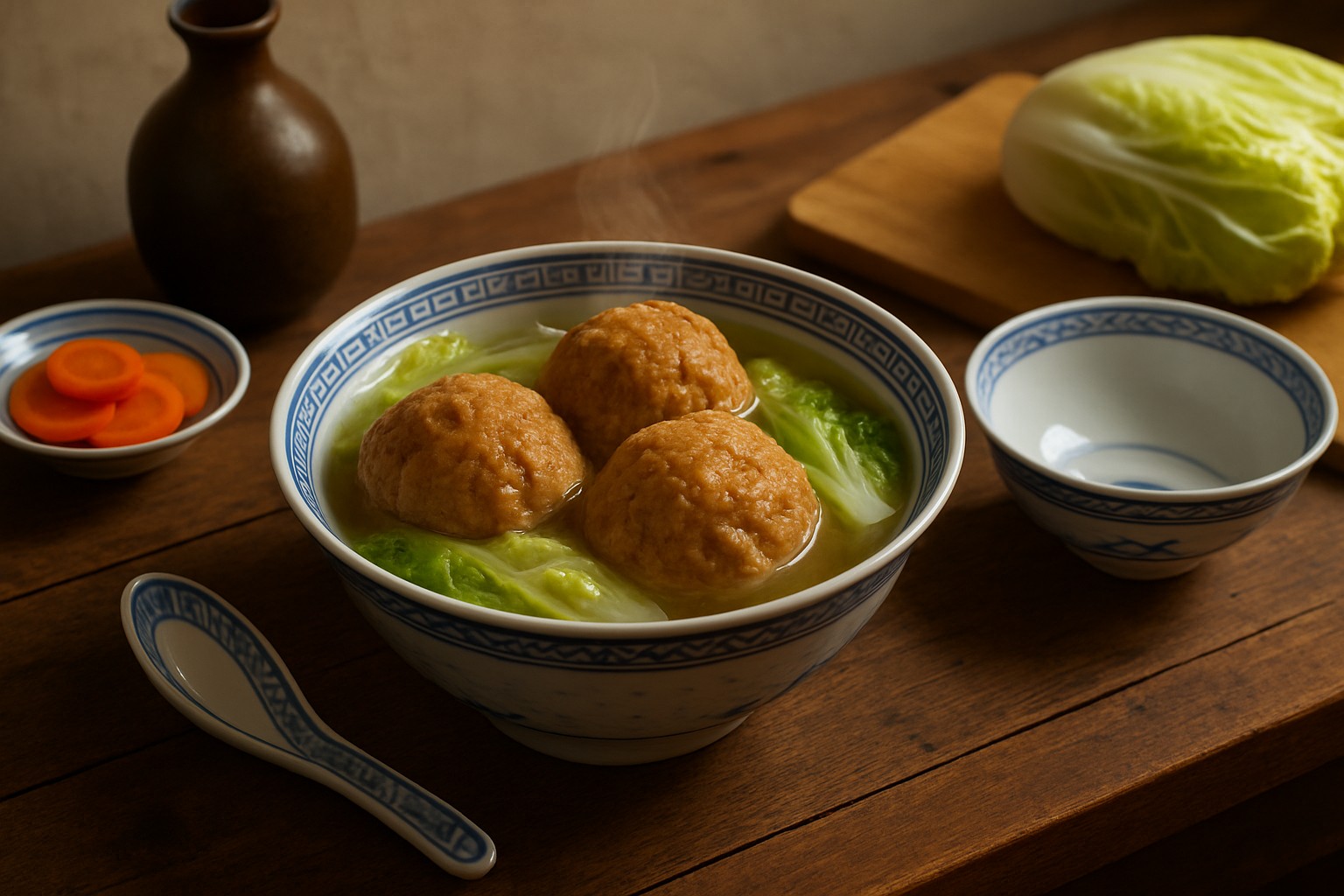How to Cook Lion Head Soup That Tastes Like Home

Lion head soup is a beloved dish from China’s Jiangsu province and often appears at family gatherings and festive moments because of its rich history and soul-soothing flavors. It quietly represents warmth and togetherness and a sweet sense of nostalgia. Making lion head soup at home is more than just cooking. It’s a comforting ritual that helps many reconnect with their roots, recall cherished memories and lovingly pass this classic recipe to younger generations.
Lion Head Soup truly stands out thanks to its quirky yet charming ingredients: large tender pork meatballs shaped to look like a lion’s head all gently simmered in a clear flavorful broth alongside Napa cabbage. The delightful blend of savory soy sauce and a lively splash of ginger pairs with the natural sweetness of the veggies and the soft almost melt-in-your-mouth texture of those meatballs to give this dish a flavor that’s hard to forget. It started out as a simple homemade classic where careful steaming and slow simmering worked their magic to develop deep rich flavors and perfect tenderness.
Taking a Closer Look at the Main Ingredients in Lion Head Soup (Because Every Great Dish Deserves a Spotlight)
Lion head soup revolves around a handful of star players: ground pork with enough fat to keep things juicy without going overboard, fresh Napa cabbage that brings a gentle sweetness and satisfying crunch, and a broth that’s savory and simple—nothing fancy but packed with cozy fragrant seasonings.
| Ingredient | Quantity | Alternative Options | Role in Recipe |
|---|---|---|---|
| Ground pork (with 20-30% fat) | 500g | Ground chicken or turkey (less juicy) | Lends the dish a tender, melt-in-your-mouth texture and rich, comforting flavor |
| Napa cabbage | 300g | Bok choy or Chinese cabbage | Adds a subtle sweetness that perfectly balances the richness |
| Ginger (minced) | 1 tbsp | Galangal (less common) | Brings a warm, aromatic kick that wakes up your taste buds |
| Soy sauce | 2 tbsp | Tamari (gluten-free) | Layers of deep umami flavor that really pull everything together |
| Shaoxing wine | 1 tbsp | Dry sherry | Gives the dish a little extra depth and complexity |
| White pepper powder | ½ tsp | Black pepper (use sparingly) | Adds a gentle, sneaky heat that lingers without overpowering |
| Chicken or pork broth | 4 cups | Vegetable broth (vegan option) | Acts as the savory, flavorful backbone of the soup |
| Cornstarch | 1 tbsp | Potato starch | Works behind the scenes to help bind the meat mixture just right |
| Scallion (chopped) | 2 stalks | Chives | Offers a fresh, sharp brightness that lifts the whole dish |
| Sesame oil | 1 tsp | Peanut oil | Adds a fragrant finishing touch that rounds everything off nicely |
Essential Tools and Kitchen Equipment
When it comes to whipping up a storm in the kitchen, having the right tools can make all the difference. From trusty knives that never fail to sharp cutting boards, the basics lay the groundwork for culinary success. Of course, as anyone who’s spent a decent amount of time cooking will tell you, these essentials are more than just utensils they’re your kitchen companions, ready to help you pull off everything from everyday meals to impressive dinner party spreads.
- Large mixing bowls perfect for tossing ingredients and letting the meatballs soak up all that goodness while marinating
- A trusty meat grinder or food processor to finely grind the pork and keep the meatballs tender and just right
- A wok or generously sized pot to gently simmer the soup broth and let the flavors mingle beautifully
- A steamer or steaming basket so you can cook the meatballs gently without rushing the magic
- A sharp knife paired with a sturdy cutting board because chopping vegetables and aromatics deserves the right tools
- Measuring spoons and cups to get your seasonings spot-on and avoid any 'oops, too salty' moments
- A slotted spoon or spider strainer to carefully scoop up the meatballs without risking a messy break-up on the way
A Step-By-Step Guide to Crafting Authentic Lion Head Soup That Warms the Soul
Getting the meatball mixture just right is absolutely important for crafting tender, flavorful Lion Head Soup that truly sings. A good rule of thumb is to strike a nice balance between lean and fatty pork. It’s a bit like finding the sweet spot in a perfect recipe.
Toss together the ground pork with minced ginger, chopped scallions, soy sauce, Shaoxing wine, white pepper, sesame oil and cornstarch in a large bowl. Stir it well in one direction until the mixture feels just a bit sticky and nicely combined. You’ll know when it’s ready.
Shape the pork mixture into large meatballs roughly the size of a golf ball or a little bigger. Handle them gently like you’re cradling a small treasure to keep them tender without packing too tightly.
Wash the Napa cabbage thoroughly and slice it into big strips or wedges. Then blanch it briefly in boiling water to soften it slightly before draining it well.
Warm the broth to a gentle simmer in a large pot or wok. Add a splash of soy sauce and Shaoxing wine to enhance the flavors.
Line the bottom of your steamer basket with a layer of Napa cabbage. This trick prevents the meatballs from sticking and makes cleanup easier. Arrange the meatballs on top in a single layer.
Steam the meatballs over boiling water for about 20 to 25 minutes. The goal is juicy tender meatballs that are fully cooked without drying out.
Carefully transfer the steamed meatballs into the simmering broth. Nestle the blanched cabbage around the edges and let everything simmer gently for another 10 minutes to allow the flavors to mingle and mellow.
Taste the broth and adjust the seasoning if needed with salt, more soy sauce or even a pinch of sugar if it needs a little extra flavor.
Serve the soup piping hot topped with extra chopped scallions or a drizzle of sesame oil for a lovely aroma. Lion Head Soup tastes best alongside steaming bowls of rice or simple stir-fried greens.

Steaming the large pork meatballs with Napa cabbage in a bamboo steamer, a key step in authentic Lion Head Soup preparation
Get tender meatballs that are perfectly cooked through by steaming them until the internal temperature reaches 160°F (71°C) or until they feel firm but still have a bit of a spring when you press them—kind of like a cozy little bounce. Keep the broth at a gentle simmer to coax out flavors that are rich yet light, and avoid a rolling boil because that tends to toughen the meat and can turn your soup cloudy—definitely not the look we’re going for.
Typical Challenges and How We Can Tackle Them
- When meatballs fall apart it usually means there’s not enough binder in the mix or you’ve given it too much of a workout. Try mixing gently and tossing in a pinch of cornstarch to help keep everything together.
- If the broth tastes flat and uninspired let it simmer a little longer with some aromatics or add a splash of Shaoxing wine to wake it up with richer notes.
- Meatballs that end up too dense often come from packing the mixture too tight. Treat them with a light touch and you’ll be rewarded with tender airy bites.
- Overcooked cabbage turns mushy. To keep a firm texture, blanch it just until it’s tender—no more no less.
- Adjust the seasoning before serving. A dash of soy sauce a sprinkle of pepper or a hint of sugar can balance the flavors just right.
"Mastering Lion Head Soup takes a fair bit of patience and practice. With every attempt, you inch a little closer to that warm, nostalgic flavor that makes this dish so delightfully special."
How to Make Your Lion Head Soup Feel Just Like Home (or Even Better)
Lion Head Soup is a deeply personal dish that varies from region to region and family to family. You can effortlessly tweak the broth's richness, play with seasonings or toss in extras like mushrooms or tofu to capture the unique flavors and memories that make the soup truly your own.
- Try swapping chicken broth for pork broth if you are after a lighter or richer base depending on what your family prefers.
- A splash of soy sauce or a dash of Shaoxing wine can really enhance the umami and make richer the mix.
- Tossing in wood ear mushrooms, shiitake or tofu brings fun textures and flavors that keep things interesting.
- Feel free to mix up the leafy greens. Bok choy or mustard greens make a great alternative to Napa cabbage when you are looking for variety.
- Adjust the seasoning until you reach the perfect balance of saltiness and sweetness that pleases your taste buds.
Suggested Ways to Serve and Pair (Because even the best flavors deserve a great sidekick)
Lion head soup serves as the star of a cozy meal that feels like a warm hug on a chilly day. It pairs beautifully with simple sides that let its delicate flavors shine without stealing the spotlight.
- Steamed jasmine or white rice just right for soaking up rich flavorful broth without stealing the spotlight
- Pickled veggies like crunchy daikon or cucumber adding a crisp refreshing kick that wakes up your taste buds
- Simple stir-fried greens such as tender bok choy or spinach bringing a fresh leafy balance to the mix
- Traditional Chinese teas like jasmine or oolong perfect for gently cleansing the palate and keeping things light
- Mild drinks like soothing chrysanthemum tea or subtly citrus-infused water pairing nicely without overwhelming the flavors





